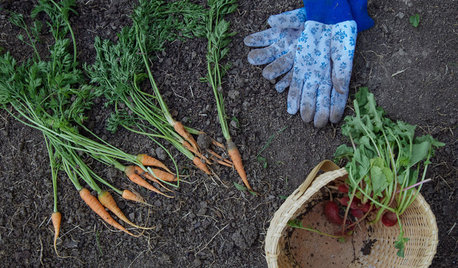Suggestions on controlling cucumber beetle?
canuckistani
14 years ago
Related Stories

GARDENING GUIDES6 Plants That Beat Butterfly Bush for the Wildlife Draw
It's invasive, a nonnative and a poor insect magnet. Check out these better alternatives to butterfly bush in the garden
Full Story
GARDENING GUIDESLessons in the Rewards of Selfless Gardening
Let go of gardening for your own vision and watch the garden’s own true vision come forth
Full Story
EDIBLE GARDENSGarden BFFs? Why Your Vegetables Are Begging for Companion Plants
Foster friendships among plants for protection from pests, pollination support and color camaraderie
Full Story
FARM YOUR YARDMy Houzz: Backyard Farming for a Kansas City Family
A backyard garden provides a family of 5 with organic seasonal produce. Here's how they do it
Full Story
GARDENING GUIDESOrganic Matters: Thwart Insect Pests With Trap Crops
Add a few sacrificial plants to your garden to lure insects away from the harvest
Full Story
GARDENING GUIDESTree Care: Common Tree Diseases and What to Do About Them
Learn to recognize trees that may be affected by diseases or pests so you can quickly take action
Full Story
GARDENING AND LANDSCAPINGBid Bad Garden Bugs Goodbye and Usher In the Good
Give ants their marching orders and send mosquitoes moseying, while creating a garden that draws pollinators and helpful eaters
Full Story
GARDENING GUIDESWe Bust 4 More Native Plant Myths
Have you been taken in by these fallacies about gardening with native plants?
Full Story
GARDENING GUIDESWhat Kind of Roses Should You Grow?
Want to add the beauty of roses to your garden? Find out which ones, from old-fashioned to modern, are right for you
Full Story
MOST POPULAR7 Ways to Design Your Kitchen to Help You Lose Weight
In his new book, Slim by Design, eating-behavior expert Brian Wansink shows us how to get our kitchens working better
Full Story

Karen Pease
riley17
Related Professionals
Windham Landscape Architects & Landscape Designers · Barrington Hills Landscape Architects & Landscape Designers · Hyattsville Landscape Architects & Landscape Designers · San Juan Landscape Architects & Landscape Designers · McKinney Landscape Contractors · Deerfield Landscape Contractors · Los Banos Landscape Contractors · Mahwah Landscape Contractors · Milford Mill Landscape Contractors · Overland Park Landscape Contractors · Stony Brook Landscape Contractors · Oxon Hill Landscape Contractors · Shafter Landscape Contractors · Grand Rapids Driveway Installation & Maintenance · Providence Driveway Installation & Maintenanceribbit32004
jimster
anney
catherinet
justaguy2
canuckistaniOriginal Author
anney
canuckistaniOriginal Author
anney
veggiefaery
wayne_5 zone 6a Central Indiana
canuckistaniOriginal Author
anney
canuckistaniOriginal Author
anney
never-give-up
anney
never-give-up
canuckistaniOriginal Author
hepatica_z7
anney
hepatica_z7
kstatefan
takadi
anney
gardener1908
never-give-up
kstatefan
anney
never-give-up
flowergirl70ks
never-give-up
gardener1908
kathy_nj
ditnc
anney
catherinet
ditnc
m_lorne
canuckistaniOriginal Author
anney
anney
canuckistaniOriginal Author
anney
justaguy2
LUANNE Luongo